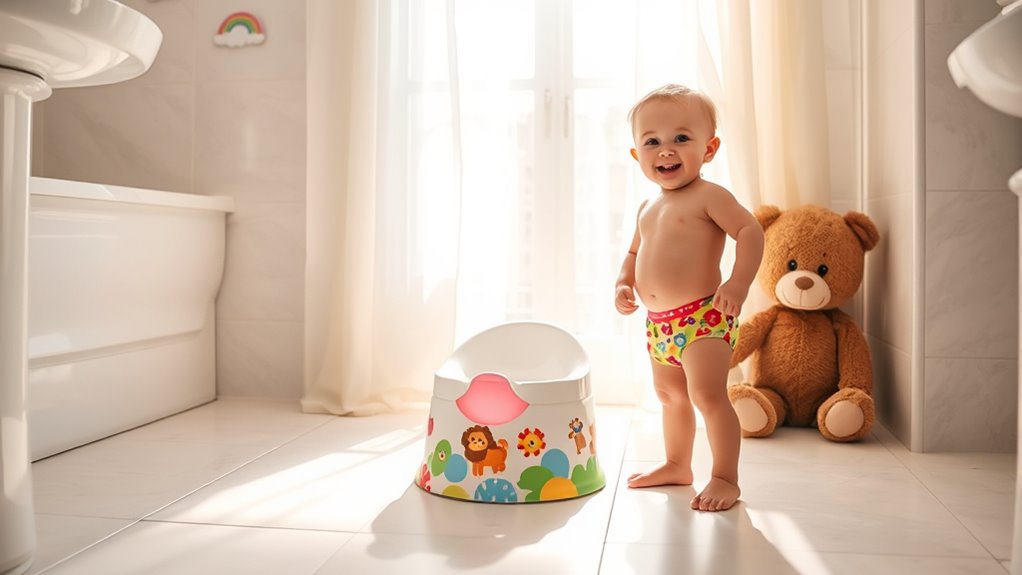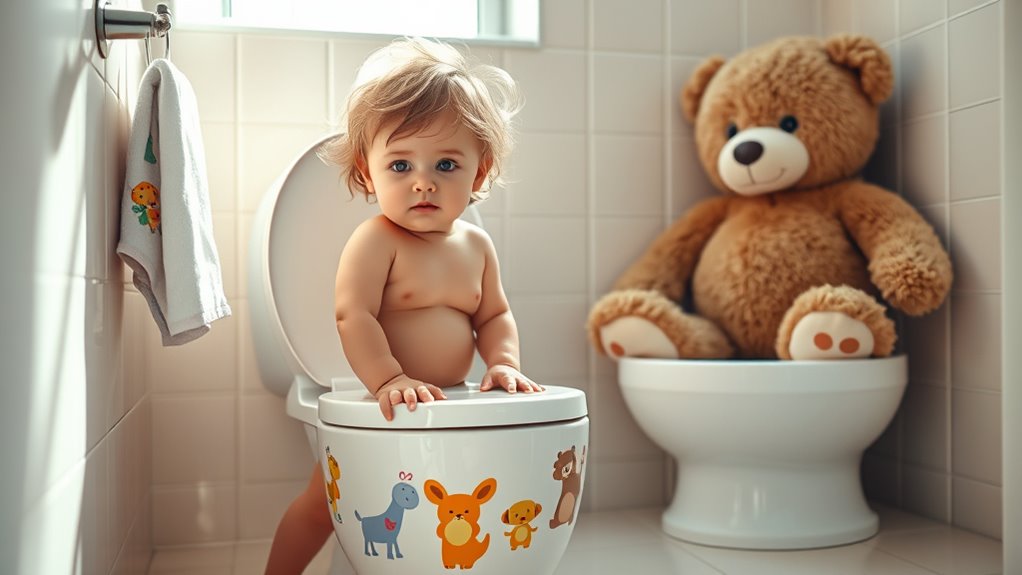The first step in potty training is assessing your child’s readiness, typically between ages 2 and 3.5. Look for signs like staying dry longer, showing discomfort with wet diapers, or expressing interest in the toilet. Make sure to avoid starting during major life changes to keep the experience positive. Once you’re ready, introduce the potty and establish a consistent routine. Keep going, and you’ll discover helpful tips to make this transition smoother.
Key Takeaways
- Assess your child’s readiness by looking for signs like staying dry longer and showing interest in the toilet.
- Introduce the potty by explaining its purpose and encouraging your child to explore it.
- Dress your child in easy-to-remove clothing to facilitate quick access to the potty.
- Establish a consistent routine by encouraging potty use after meals and at regular intervals.
- Be patient and supportive, celebrating successes and handling accidents calmly to reinforce learning.

Potty training can feel like a daunting task, but with the right approach, it becomes a manageable and rewarding experience for both you and your child. To start, you’ll want to consider your child’s readiness. Most kids aren’t ready until they’re at least 2 years old, and some might take even longer. Look for signs of readiness, like your child staying dry for longer periods, showing discomfort with a wet diaper, or expressing interest in the toilet. Developmental readiness typically occurs between ages 2 and 3.5.
It’s essential to choose a time when you’re both in a stable environment, steering clear of major changes that could disrupt the process.
Once you’ve established that your child is ready, it’s time to introduce the potty. Start gradually by explaining what the potty is for and encouraging your child to explore it. Make sure to dress them in easy-to-remove clothing, as this will help them feel more independent and capable during the training process.
You can also set up a consistent routine by using the same bathroom-related vocabulary, which helps your child understand what’s expected. Place the potty in accessible locations, such as the bathroom or a nearby room, so your child doesn’t have to wander far. Encourage them to use the potty after meals to take advantage of their natural bowel movements.
Establish regular sitting times, like after waking up or before bedtime, to reinforce the habit. Engaging them with visual aids, such as books or videos about potty training, can also make the experience more enjoyable.
When it comes to methods, consider a child-led approach. Allow your child to take the initiative and make choices about using the potty. You might also try the naked or bare-bottom method to help them become aware of their bodily functions.
Alternatively, the three-day method focuses on a rapid transition to underwear, while the Oh Crap method breaks it down into manageable stages.
Throughout the process, be patient and consistent. Accidents will happen, and it’s important to maintain a calm demeanor. Allow your child to experience natural consequences, and don’t forget to celebrate their successes with praise and rewards.
Observing for signs that they need to use the potty will help you guide them effectively. As your child progresses, keep them motivated by offering choices and visual reminders like charts or stickers.
This journey won’t only boost their confidence but will also strengthen your bond as you navigate this important milestone together.
Frequently Asked Questions
What Age Is Best to Start Potty Training?
The best age to start potty training usually falls between 2 and 3 years old.
By this time, most children show signs of readiness, like interest in the toilet and communication skills.
You’ll want to watch for these cues, as starting too early can lead to frustration.
Every child is different, so be patient and flexible, allowing your child to lead the process at their own pace.
How Do I Choose the Right Potty Chair?
Choosing the right potty chair is like picking the perfect pair of shoes; it needs to fit just right.
Start by considering comfort, stability, and ease of cleaning. You want a chair that’s the right size for your child, with engaging features to make it fun.
Look for options that are portable and adaptable as they grow. Involve your child in the selection process, so they feel excited about using it!
Should I Use Rewards During Potty Training?
Using rewards during potty training can be a great way to motivate your child. Immediate rewards, like stickers or praise, reinforce the behavior and help create a positive association with using the potty.
However, be cautious; if overused, rewards might lead to power struggles or decreased intrinsic motivation. Start with consistent rewards, then gradually phase them out as your child gains confidence and learns to take pride in their progress.
What Signs Indicate My Child Is Ready?
“Where there’s smoke, there’s fire.” Look for signs that show your child’s ready for this next step.
They may communicate their needs through gestures or words and follow simple directions.
Observe if they stay dry for longer periods and express discomfort with wet or dirty diapers.
If they show curiosity about the bathroom and imitate others, it’s a good indication they’re ready to start using the potty independently.
How Long Does Potty Training Typically Take?
Potty training typically takes around six weeks to see some success, but full training can take about three months.
Your child’s readiness, your involvement, and the training method you choose can all influence the duration.
If you start later, you might find the process is quicker, sometimes only a few days.
Conclusion
With patience and consistency, you’ll have your little one potty trained in no time. Just remember, every child is different, so don’t rush the process. Trust your instincts and celebrate the small victories along the way. Before you know it, your child will be ready to take the plunge, leaving diapers behind. So, keep your chin up and stay positive; this is just the beginning of a new chapter in their growing journey!









